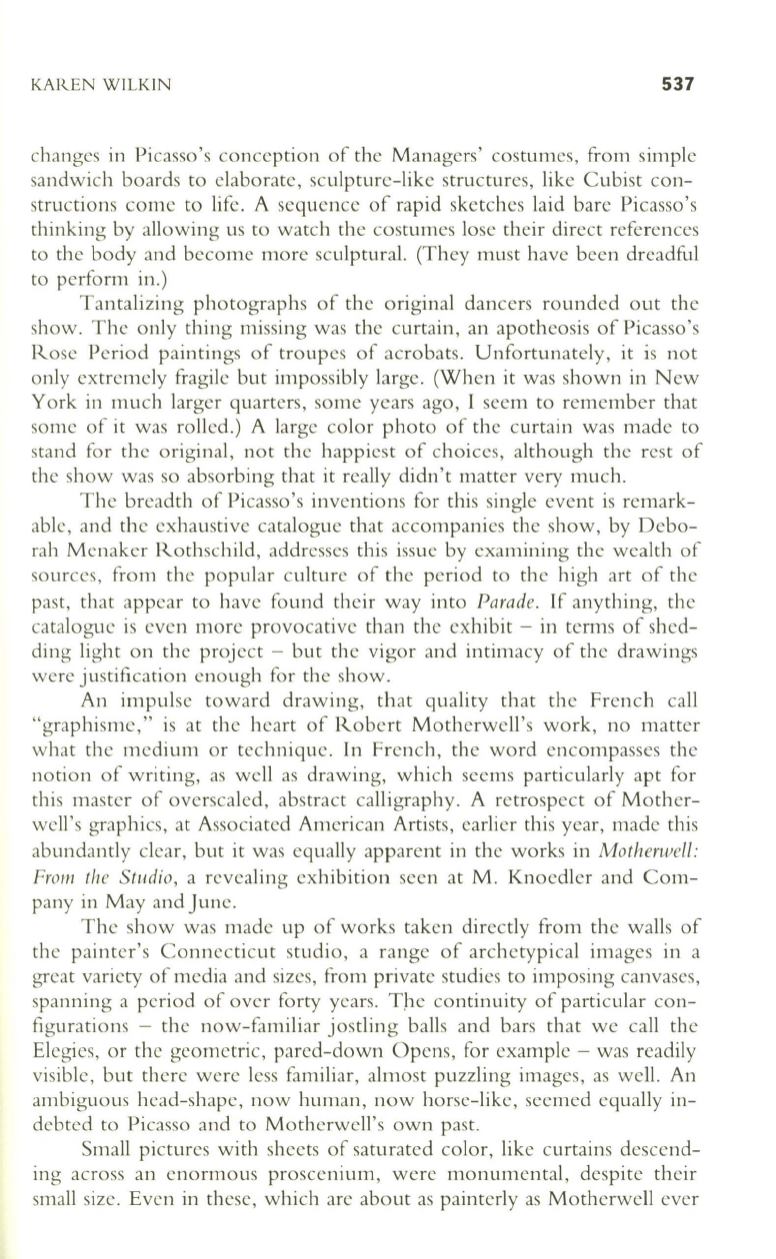
KAREN WILKIN
537
changes in Picasso's conception of the Managers' costumes, from simple
sandwich boards to elaborate, sculpture-like structures, like Cubist con–
structions come to life. A sequence of rapid sketches laid bare Picasso's
thinking by allowing us to watch the costumes lose their direct references
to the body and become more sculptural. (They must have been dreadful
to perform in.)
Tantalizing photographs of the original dancers rounded out the
show. The only thing missing was the curtain, an apotheosis of Picasso's
Rose Period paintings of troupes of acrobats. Unfortunately, it is not
only extremely fragile but impossibly large. (When it was shown in New
York in much larger quarters, some years ago, I seem to remember that
some of it was rolled.) A large color photo of the curtain was made to
stand for the original, not the happiest of choices, although the rest of
the show was so absorbing that it really didn't matter very much.
The breadth of Picasso's inventions for this single event is remark–
able, and the exhaustive catalogue that accompanies the show, by Debo–
rah Menaker Rothschild, addresses this issue by examining the wealth of
sources, from the popular culture of the period to the high art of the
past, that appear to have found their way into
Parade.
If
anything, the
catalogue is even more provocative than the exhibit - in terms of shed–
ding light on the project - but the vigor and intimacy of the drawings
were justification enough for the show.
An impulse toward drawing, that quality that the French call
"graphisme," is at the heart of Robert Motherwell's work, no matter
what the medium or technique. In French, the word encompasses the
notion of writing, as well as drawing, which seems particularly apt for
this master of overscaled, abstract calligraphy. A retrospect of Mother–
well's graphics, at Associated American Artists, earlier this year, made this
abundantly clear, but it was equally apparent in the works in
Motherwell:
From the Studio,
a revealing exhibition seen at M. Knoedler and Com–
pany in May and June.
The show was made up of works taken directly from the walls of
the painter's Connecticut studio, a range of archetypical images in a
great variety of media and sizes, from private studies to imposing canvases,
spanning a period of over forty years. The continuity of particular con–
figurations - the now-familiar jostling balls and bars that we call the
Elegies, or the geometric, pared-down Opens, for example - was readily
visible, but there were less familiar, almost puzzling images, as well. An
ambiguous head-shape, now human, now horse-like, seemed equally in–
debted to Picasso and to Motherwell's own past.
Small pictures with sheets of saturated color, like curtains descend–
ing across an enormous proscenium, were monumental, despite their
small size. Even in these, which are about as painterly as Motherwell ever


